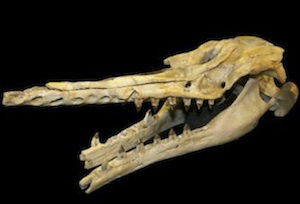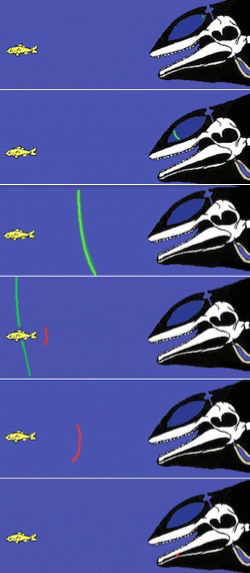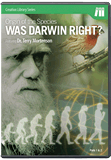
Whale Skull Equipped for Sonar Shows Echolocation Appears Abruptly in the Fossil Record
News to Know
Abstract
Moby Dick’s ancient cousin was well-equipped with sonar for hunting and mapping the bottom of the sea.
News Source
- ScienceDaily: “New Fossil Species: Origin of Toothed Whale Echolocation”
Call him Cotylocara macei. Cotylocara means “cavity head.” Found in a drainage ditch near Charleston, South Carolina, in rock conventionally dated about 28 million years old, this whale’s skull suggests he was—like today’s toothed whales—fully equipped for echolocation. Cotylocara’s cavities and other features show he probably had all it takes to use sonar to snag his dinner and negotiate his way through the dark ocean depths.

This whale skull found near Charleston, South Carolina, displays the bony features associated with modern toothed whale echolocation. If the corresponding soft tissues were also present, then this animal was all set for sonar. Image: James Carew and Mitchell Colgan, via Science Daily.1
Sonar Instead of Songs
Whales can be grouped as baleen whales and toothed whales, and both seem to use sound to communicate with each other. Baleen whales—like blue whales and humpback whales—filter plankton from the water using baleen plates and sing songs. Their anatomy does not appear to equip them for echolocation.2 Dolphins, porpoises, and toothed whales—like killer whales and Moby Dick the sperm whale—use sonar to bounce sound off objects, sensing the details of the darkest depths and the precise location of edible prey.
The Shape of Sonar
Odontocetes (toothed whales, dolphins, and porpoises) today possess several anatomical features that equip them for precision sonar. They have phonic lips, which form narrow membrane-lined passages beneath the blowhole. The membranes vibrate to generate high-frequency sound waves as air passes through.3 The air is then recycled through a vestibular sac or blown out the blowhole. The sound waves are modulated in air sinuses and pass through a lens-shaped “melon” composed of lipid layers. The characteristics and the arrangement of these lipids modifies the sound waves. Muscles in the face adjust the melon’s shape to focus the sonic waves as they leave the whale’s head.
Asymmetrical skull bones are standard equipment on echolocating odontocetes. Most have the median plane shifted to the left and also have some structural features that are larger on the right. Cetacean biologists are still working out how asymmetry contributes to echolocation.
Echolocation requires not only sound-generating structures but also receivers to capture, transmit, and interpret the sound waves that bounce back. To direct the sound waves bouncing back from rocks and prey to the auditory center, odontocetes have specialized fat deposits stashed in large canal-like cavities in their jaws.4 As with all kinds of creatures, details vary among species. For instance, the front part of the upper jaw in Cuvier’s beaked whale is quite dense and protruding, and cetacean biologists think it might act as an acoustic reflector.

This diagram from the study in Nature shows a group of archaeocetes (left), baleen whales (above the “M” for “mystocetes”), and toothed whales (above the “O” for “odontocetes” on the right). Cotylocara is a typical toothed whale and is indicated within that group. Like other odontocetes, its skull was equipped with the features associated with echolocation. Archaeocetes, a diverse collection of terrestrial animals and serpentine sea mammals, are popularly considered the evolutionary ancestors of whales, but in reality these are not, as evolutionary textbooks assert, transitional forms. Baleen whales and toothed whales could represent separate created kinds or distinctive varieties within the whale kind, but both are clearly whales.5 Many varieties of each exist, as we would expect—based on both observable biology and biblical principles—that animals reproduce and vary within their created kinds. Image by Jonathan H. Geisler, via Nature.6
Set for Sonar

Cetaceans like dolphins and toothed whales use sonar to detect environmental details in the dark and to locate prey. Sound waves generated by forcing air through vibrating phonic lips and modulated in the air sinuses is then focused in the melon (an acoustic lens made of layered lipids), as shown by the green wave in the first three diagrams. A portion of the sound wave (red) bounces back from the fish to be transmitted through fat-filled canals in the jaw to the auditory center. Image by Malene, via Wikimedia Commons.
Many of the features that make sonar work so well in living odontocetes are soft tissues that are not typically preserved in fossils. However, the bony features common to modern odontocetes are preserved quite well in Cotylocara macei.
Cotylocara’s skull, like that of other toothed whales, is asymmetrical. The median plane is shifted to the left as in other odontocetes, though there are some larger features on the left rather than the right. The front of Cotylocara’s jaw is dense and overhanging like that of Cuvier’s beaked whale. Cotylocara has large bony cavities consistent with substantial air sinuses in front of and behind the nasal bones. This likewise is reminiscent of the air sinuses seen in living odontocetes, even revealing a preserved thin median septum in the posterior sinus corresponding to a similar bony layer in many living odontocetes.7 Though muscles are not preserved in the fossil, Cotylocara has a very wide, sturdy upper jawbone which could have provided the attachment point for the powerful muscles8 that surround the sound-producing structures in modern odontocetes.
“Taken together, the cranial features described above make a compelling case that Cotylocara could echolocate, and that has important implications for the origin of this complex behaviour,”9 the authors write in “A new fossil species supports an early origin for toothed whale echolocation,” published in Nature. “Its dense bones and air sinuses would have helped this whale focus its vocalizations into a probing beam of sound, which likely helped it find food at night or in muddy water ocean waters,” says lead author Jonathan Geisler. “The most important conclusion of our study involves the evolution of echolocation and the complex anatomy that underlies this behavior. This was occurring at the same time that whales were diversifying in terms of feeding behavior, body size, and relative brain size.” Geisler adds, “The anatomy of the skull is really unusual. I've not seen anything like this in any other whale, living or extinct.”
Variations on a Theme
Having all the bony requirements for echolocation in place, Cotylocara, suggest the authors, had evolved a rudimentary form of echolocation and that the muscles to make the system work well evolved soon after,10 given that the bony attachments and cavities are all in place. However, since muscles are not typically preserved in fossils, they are only assuming that the muscles needed to trick out the echolocation equipment were not present in Cotylocara.
The authors conclude that this whale lived soon after baleen and toothed whales diverged from each other. They propose that the needed muscles soon evolved and that afterward convergent evolution produced many variations in skull shape as seen in both extinct and living odontocetes. The strongest claim the authors make for this animal representing an intermediate (transitional) form rests on its comparison to archaeocetes.
Since muscles are not typically preserved in fossils, they are only assuming that the muscles needed for echolocation were not present in Cotylocara.
Archaeocetes are believed by evolutionists to be the evolutionary ancestors of baleen and toothed whales, and it is in this group they claim that terrestrial tetrapods transitioned to the great sea mammals. Archaeocetes comprise a diverse group that includes some animals (like Basilosaurus) that appear to have been non-cetacean sea mammals with tiny so-called hind “limbs” consistent with reproductive claspers, animals (like Pakicetus) that were clearly terrestrial animals, and other animals for which the necessary fossils to evaluate locomotion are distinctly lacking. There is no evidence for a transition from land life to aquatic life, nor any reason to consider archaeocetes to be the evolutionary forebears of whales.
Several animals classified as archaeocetes exhibit some degree of cranial asymmetry. Those that have been examined so far have their midlines twisted or shifted a little to the right, in the opposite direction of the odontocetes, though it is not marked and some have suggested the asymmetry may even be an artifact of being deformed during burial.11 The authors suggest that Cotylocara was transitioning from a pre-echolocating evolutionary ancestor, in process of completely reversing the direction in which the bones in its skull are twisted. This presumption is based on the belief that terrestrial animals evolved into whales. The existence of some animals that might have had some degree of cranial asymmetry along with a number of features that do no identify them as whales does not make a case for evolutionary transitions, only for variety among animals of various kinds of aquatic and terrestrial animals.
When baleen and toothed whales do appear in the fossil record, they appear “abruptly,”12 without any believable transitional intermediates to pave the way to them. The millions-of-year dates assigned to them are based on a collection of unverifiable assumptions. As Cotylocara illustrates, echolocating whales were equipped for echolocation all along, ever since God created all kinds of animals about 6,000 years ago, designing them to reproduce and vary only within their created kinds. While Geisler notes that there are differences in this skull compared to those of other whales, it is the similarities that are most striking. With bony cavities to accommodate air sinuses and a melon, cranial asymmetry, a dense protruding section of the upper jaw as is found in some modern echolocating whales, and a broad foundation for the necessary facial muscles, Cotylocara appears to have simply been a species of odontocete that is now extinct.
Further Reading
- Fossil Evidence of Whale Evolution?
- Do Genetic Similarities in Bats and Dolphins Echo Evolutionary Convergence?
- Twisted Whale Tale
- Big Mouths To Baleen
- ICR: Whale Variations Support Creation
- Walking Whales, Nested Hierarchies, and Chimeras: Do They Exist?
- Whales in the Desert?
- Big Blue
- Dead Whales: Telling Tales?
- Land Ho!
And Don’t Miss . . .
- We spent some time earlier this week in the sea as well, seeing how those who believe the oceans oxygenated themselves did so, and were puzzled why an apparently “sacred cow” of evolution, Darwin’s finches, must not be allowed to preserve themselves via natural selection.
- Are you watching the Cosmos series? Need some answers? Check here weekly for an assessment of the claims in the latest episode.
- This coming week, we’ll take another dive to see what the sea anemone has to teach those who already believe we have a common ancestor with them. And who knows what else will be in the News?
For More Information: Get Answers
Remember, if you see a news story that might merit some attention, let us know about it! (Note: if the story originates from the Associated Press, FOX News, MSNBC, the New York Times, or another major national media outlet, we will most likely have already heard about it.) And thanks to all of our readers who have submitted great news tips to us. If you didn’t catch all the latest News to Know, why not take a look to see what you’ve missed?
(Please note that links will take you directly to the source. Answers in Genesis is not responsible for content on the websites to which we refer. For more information, please see our Privacy Policy.)
Footnotes
- New York Institute of Technology, “New Fossil Species: Origin of Toothted Whale Echolocation,” ScienceDaily, March 12, 2014, https://www.sciencedaily.com/releases/2014/03/140312150103.htm.
- Fatty deposits in what is thought to be the sound-conducting pathway of the humpback whale as well as analysis of some baleen whale song has led to speculation about whether baleen whales might also echolocate, but as a group they lack certain features associated with echolocation in toothed whales. Given that both groups live in the ocean where it can be quite dark, it would be no surprise to learn that baleen whales echolocate to some extent. If they do, then we can at least say their equipment differs from the well-documented, anatomically supported sonar setup found in toothed whales and dolphins. For instance, humpbacks lack the lens-like melon to focus sound waves, and they generate their sounds using a larynx, not phonic lips.
- All but the sperm whale have both right and left sets of phonic lips and can therefore produce two different frequencies of sound at the same time. Moby Dick was a literary sperm whale. Therefore, unlike other toothed whales, he couldn’t hunt for Captain Ahab in stereo.
- Humpback whales also seem to be designed with a fat-filled sound path, but baleen whales lack the large cavities found in toothed whales. See Woods Hole Oceanographic Institution, “Understanding of Hearing in Baleen Whales Amplified,” ScienceDaily, April 17, 2012, https://www.sciencedaily.com/releases/2012/04/120417113640.htm.
- While archaeocetes are a diverse group of animals, baleen and toothed whales are clearly both whales. Whether they are separate created kinds or varieties of the same whale kind is still a matter of discussion. More recent discoveries support the latter position. Developing baleen whales can develop teeth that are later reabsorbed. Also, at least two fossil whale skulls appear to have both teeth and baleen. These are not intermediate (transitional) evolutionary forms, however, as baleen whales, toothed whales, and whales expressing the genes for both are all still whales.
- Jonathan H. Geisler et al., “A New Fossil Species Supports an Early Origin for Toothed Whale Echolocation,” Nature 508 (March 12, 2014): 383–386, doi:10.1038/nature13086.
- Details such as this, which provide more information than that available in the popular press, are drawn for this article directly from the peer-reviewed journal article published in Nature (Geisler et al., “A New Fossil Species Supports an Early Origin for Toothed Whale Echolocation.”
- The maxillonasolabialis muscle is a powerful facial muscle that inserts around the blowhole and nasal passages. As part of the facial muscle complex it is part of the apparatus that generates the outgoing sonar wave.
- Geisler et al., “A New Fossil Species Supports an Early Origin for Toothed Whale Echolocation.”
- The authors write that Cotylocara “has several features suggestive of echolocation: a dense, thick and downturned rostrum; air sac fossae; cranial asymmetry; and exceptionally broad maxillae. Our phylogenetic analysis places Cotylocara in a basal clade of odontocetes, leading us to infer that a rudimentary form of echolocation evolved in the early Oligocene, shortly after odontocetes diverged from the ancestors of filter-feeding whales (mysticetes). This was followed by enlargement of the facial muscles that modulate echolocation calls, which in turn led to marked, convergent changes in skull shape in the ancestors of Cotylocara, and in the lineage leading to extant odontocetes.” From Geisler et al., “A New Fossil Species Supports an Early Origin for Toothed Whale Echolocation.”
- Julia M. Fahlke, Philip D. Gingerich, Robert C. Welsh, and Aaron R. Wood, “Cranial Asymmetry in Eocene Archaeocete Whales and the Evolution of Directional Hearing in Water,” PNAS 108, no. 35 (August 30, 2011): 14545–14548, doi:10.1073/pnas.1108927108.
- Jonathan Sarfati, “Whale Evolution?,” chapter 5 in Refuting Evolution: A Handbook for Students, Parents, and Teachers Countering the Latest Arguments for Evolution (Green Forest, AR: Master Books, 1999), http://creation.com/refuting-evolution-chapter-5-whale-evolution.
Recommended Resources

Answers in Genesis is an apologetics ministry, dedicated to helping Christians defend their faith and proclaim the good news of Jesus Christ.
- Customer Service 800.778.3390
- © 2025 Answers in Genesis




